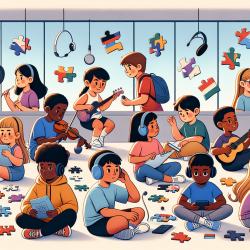Introduction
As practitioners in the field of speech-language pathology, our primary goal is to enhance the communicative abilities of children. To achieve this, it is crucial to understand the underlying mechanisms of brain development. A recent study titled "Structural brain network lateralization across childhood and adolescence" provides valuable insights into the lateralization of brain networks during crucial developmental stages. This blog will explore how these findings can be applied in practice to improve outcomes for children.
The Importance of Brain Lateralization
Brain lateralization refers to the specialization of certain functions within one hemisphere of the brain. This phenomenon is well-documented in adults, but its development during childhood and adolescence has been less explored. The study by Craig et al. (2023) delves into this area, providing a comprehensive analysis of structural connectivity patterns in children and adolescents.
Key Findings from the Study
The study utilized a graph theory approach to examine structural connectivity in the brain's hemispheres. Key metrics such as global efficiency, clustering coefficient (CC), betweenness centrality (BC), and hierarchical complexity (HC) were analyzed across different age groups. The findings revealed:
- Leftward Lateralization: Global efficiency, HC, and CC showed a leftward lateralization, indicating a higher efficiency of information transfer and clustering of connections in the left hemisphere.
- Rightward Lateralization: BC demonstrated a rightward lateralization, suggesting the presence of hub-nodes predominantly in the right hemisphere.
- Network-Specific Lateralization: The sensorimotor, default mode, salience, and language networks exhibited leftward asymmetry of CC, while BC was lateralized in the salience (right) and dorsal attention (left) networks.
Interestingly, the study found that these patterns of lateralization remained relatively constant throughout school-age development, despite changes in white matter properties.
Implications for Practice
Understanding the lateralization of brain networks can significantly impact therapeutic approaches in speech-language pathology. Here are some ways practitioners can leverage these findings:
- Targeted Interventions: By recognizing the lateralization patterns in language networks, practitioners can design interventions that align with the brain's natural processing strengths, potentially enhancing therapy outcomes.
- Monitoring Development: Consistent lateralization patterns provide a baseline for identifying atypical development. Practitioners can use this information to monitor progress and adjust interventions as needed.
- Collaborative Research: The study highlights the importance of understanding brain lateralization in typically developing populations. Practitioners are encouraged to engage in further research to explore these mechanisms in children with neurological disorders.
Encouraging Further Research
The study by Craig et al. opens the door for further exploration into the relationship between brain lateralization and language development. Practitioners are encouraged to delve deeper into this area, contributing to a growing body of knowledge that can inform evidence-based practices.
Conclusion
The lateralization of brain networks is a critical aspect of childhood development that can inform therapeutic practices. By understanding and applying the findings from this study, practitioners can enhance their interventions and support better outcomes for children. For those interested in exploring this research further, the original paper can be accessed here: Structural brain network lateralization across childhood and adolescence.










